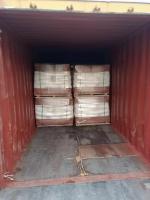Cationic polyacrylamide of Praestol 8510BC Praestol 835BS 852 BC can be replaced by Chinafloc c
Cationic polyacrylamide of Praestol 8510BC Praestol 835BS 852 BC are three kinds of cationic polyacrylamide with medium and high charge and high molecular weight ,can be used for water treatment and sludge dewatering.chinafloc C3 serie can replace of them and with good result
Cationic polyacrylamide (CPAM) is a linear polymer compound, because it has a variety of active groups, and many substances affinity, adsorption form hydrogen bonds. Mainly flocculating negatively charged colloid, with turbidity removal, decolorization, adsorption, adhesion and other functions, suitable for dyeing, papermaking, food, construction, metallurgy, mineral processing, coal powder, oil fields, aquatic products processing and fermentation industries of organic colloid content is higher wastewater treatment, especially suitable for urban sewage, urban sludge, paper sludge and other industrial sludge dewatering treatment. Above the application of cationic polyacrylamide introduction is more general, let's talk about the application of cationic polyacrylamide in detail.
https://youtube.com/shorts/7nmNi2HS7Kw?feature=share
The more commonly used cationic monomers in the synthesis of cationic polyacrylamide are methyl acryloxyethyl trimethyl ammonium chloride (DMC), acrylyl hydroxyethyl trimethyl ammonium chloride (DAC), dimethyl diallyl ammonium chloride (DMDAAC), acrylyl aminopropyltrimethyl ammonium chloride (AMPTAC), methacrylic acid -2-(N, N- dimethyl amino) ethyl ester (DM), acrylic acid -2-(N, N- dimethyl amino) ethyl ester (DA), etc. Although the country has a national standard for cationic polyacrylamide, but we usually say that some indicators are actually their own enterprise standards, each standard is not the same, the error is relatively large. For cations, one of the indicators that people usually talk about more is the ionic degree, what does the ionic degree of cationic polyacrylamide mean? Ion is simply the number of charges carried by polyacrylamide, according to the level of charge is divided into low cationic, medium cationic and high cationic. The role of cationic polyacrylamide is to use the molecular charge and sludge particles with the opposite charge, positive and negative charge neutralization to make it unstable. Many fine sludge particles are adsorbed and entangled together by the long chain action of its polymer to form larger particles.
1, cationic polyacrylamide used for sludge dehydration according to the nature of the sludge can choose the corresponding brand of this product, can effectively in the sludge into the sludge dehydration before dewatering, dewatering, the production of large floc, non-stick filter cloth, press filter does not disperse, mud cake is thick, high dehydration efficiency, mud cake moisture content below 80%.
2, used for the treatment of domestic sewage and organic wastewater, this product in the distribution or alkaline medium are positive, so the sewage suspended particles with negative charge into flocculation precipitation, clarification is very effective. Such as the production of food alcohol wastewater, paper waste water, urban sewage treatment plant wastewater, beer wastewater, monosodium glutamate plant wastewater, sugar wastewater, high organic content wastewater, feed wastewater, textile printing and dyeing wastewater, cationic polyacrylamide than anionic, non-ionic polyacrylamide or inorganic salt class effect is several times higher or dozens of times, because this kind of wastewater is generally negative charge.
3, cationic polyacrylamide used in the treatment of river water as the source of water flocculant, less dosage, good effect, low cost, especially polyacrylamide and inorganic flocculant compound use effect is better, it will become the Yangtze River, Yellow River and other river basin of the water plant of high efficiency flocculant.
4, paper reinforcement and other auxiliaries.
5, cationic polyacrylamide used in oil field economic additives, such as clay swelling agent, oilfield acidification with thickening agent.

